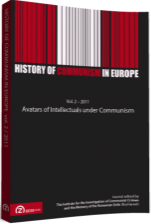Co-option and Control: The Changing Profile of the Historical Front in Communist Romania at the End of the Fifties
Co-option and Control: The Changing Profile of the Historical Front in Communist Romania at the End of the Fifties
Author(s): Bogdan C. IacobSubject(s): History
Published by: Zeta Books
Keywords: de-Stalinization; Academy; historical front; regime individuality; nationalism
Summary/Abstract: The 1948 transformation of the Academy, combined with extensive purges of the higher education system qualifies as a Great Break, Romanian style, within the scientific field. In 1955, at the 2nd RWP Congress, the communist regime adopted, within the academic realm, an approach of simultaneously fulfilling the goals of the cultural revolution and promoting the reformed old intelligentsia, compliant bourgeois specialists. As the RWP was searching for an identity in the context of de-Stalinization, the role of science changed, bringing along with it significant transformations both at a personnel and thematic level. The RWP targeted both co-option and control. It is the thesis of the present article that from 1955 to 1963 the historical front gained a polycentric profi le. Various groups converged towards the same point: the creation of both the ideological and infrastructural basis for the master narrative about Romania’s evolution into socialism. Once the axiomatic but creative role of the present in making sense of the national past was commonly accepted, a new productive equilibrium was reached on the historical front.
Journal: History of Communism in Europe
- Issue Year: 2011
- Issue No: 2
- Page Range: 197-226
- Page Count: 30
- Language: English
- Content File-PDF

